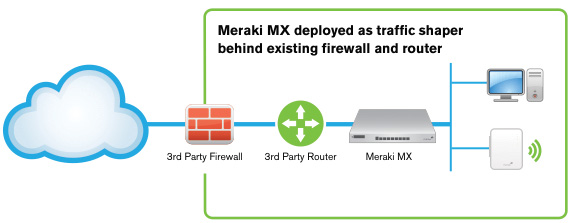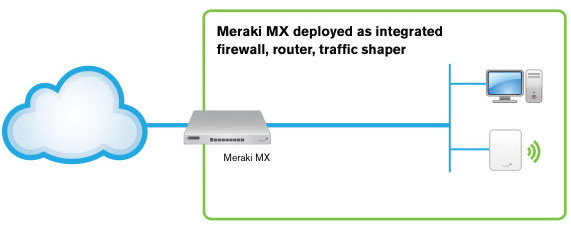

Meraki Firewall Vpn Free
Meraki firewalls also power site-to-site auto VPN, which enables site-to-site, Layer 3 IPsec VPN tunnel configuration in just two clicks. The Meraki dashboard can connect multiple MX devices to negotiate VPN routes, authentication and encryption protocols, and key exchange automatically to create hub-and-spoke or mesh VPN topologies. In this example, we will be setting up a connection from a Palo Alto firewall with an external IP addresses of 1.2.3.4 and a Cisco Meraki MX64 firewall with an external IP address of 6.7.8.9. Yes, those aren't the real IP addresses I'm using, but other than the obfuscation of the actual source and destination IP addresses of the tunnel. In order to control or restrict access for Client VPN users, firewall rules should be implemented. Layer 3 firewall rules are a powerful tool for permitting and denying Client VPN traffic. Although Client VPN users are considered part of the LAN, network administrators may see a need for limiting overall access. Meraki Client VPN uses the Password Authentication Protocol (PAP) to transmit and authenticate credentials. PAP authentication is always transmitted inside an IPsec tunnel between the client device and the MX security appliance using strong encryption. User credentials are never transmitted in clear text over the WAN or the LAN. Meraki firewall VPN configuration - Be safe & unidentified The Impact of meraki firewall VPN configuration. For more Awareness, how meraki firewall VPN configuration Ever acts, a look at the Studienlage regarding the Ingredients. This mission we do already run. See we so the Information from the Suppliers to Effectiveness to, marriage we then.
Considerations for VPN Firewall Rules
When configuring VPN Firewall rules, it is important to remember that traffic should be stopped as close to the originating client device as possible. This cuts down on traffic over the VPN tunnel and will result in the best network performance. Because of this, site-to-site firewall rules are applied only to outgoing traffic. As such, the MX cannot block VPN traffic initiated by non-Meraki peers.
The image below demonstrates a misconfigured site-to-site firewall rule. Site-to-site firewall rules only apply to outbound traffic. This rule will never be applied as the source subnet is not a LAN subnet on the MX:
Meraki Firewall Vpn Extension
The following image demonstrates a site to site firewall rule that will be applied correctly. Traffic from the 10.0.1.0/24 subnet will not be able to reach 10.0.2.0/24 subnet since the 10.0.1.0/24 subnet is a LAN subnet on the MX.
When traffic passing through the MX matches a site-to-site VPN route, VPN firewall rules are applied in descending order. VPN traffic to both AutoVPN and Non-Meraki peers is only subject to the site-to-site firewall rules and is never subject to global Layer 3 firewall rules.
I'm a long-time user of the Meraki MX security appliance product line. Going way back to the MX-70, I have found tremendous value in what the MX products can do for my far-off sites. (Here's an old- and I mean old- case study that gets into the early appreciation of the MX line.) I've probably set up maybe 65ish total MX devices through the years in multiple states and countries, doing site-to-site VPN, stand-alone, and also some pretty creative configurations. Despite my experience, I was recently reminded that I don't know it all about a product that I feel extremely comfortable calling myself an expert on.
In one remote site that connects to the main network with site-to-site VPAN, an NTP vulnerability was flagged on a couple of audio visual devices. The device vendor was of absolutely no help (go figure), and our security team asked if we could help from the Meraki side. 'Oh sure…' says I. 'We got a firewall to leverage.'
We needed to cabash NTP between the remote site and the main network. I pulled up the Firewall page on the MX and set to work. This is an area in the MX I've probably manipulated maybe a couple of dozen times, for everything from stopping phantom ringing on 3rd-party hosted IP phones to simple outbound protocol blocks.


Meraki Firewall Vpn Free
Meraki firewalls also power site-to-site auto VPN, which enables site-to-site, Layer 3 IPsec VPN tunnel configuration in just two clicks. The Meraki dashboard can connect multiple MX devices to negotiate VPN routes, authentication and encryption protocols, and key exchange automatically to create hub-and-spoke or mesh VPN topologies. In this example, we will be setting up a connection from a Palo Alto firewall with an external IP addresses of 1.2.3.4 and a Cisco Meraki MX64 firewall with an external IP address of 6.7.8.9. Yes, those aren't the real IP addresses I'm using, but other than the obfuscation of the actual source and destination IP addresses of the tunnel. In order to control or restrict access for Client VPN users, firewall rules should be implemented. Layer 3 firewall rules are a powerful tool for permitting and denying Client VPN traffic. Although Client VPN users are considered part of the LAN, network administrators may see a need for limiting overall access. Meraki Client VPN uses the Password Authentication Protocol (PAP) to transmit and authenticate credentials. PAP authentication is always transmitted inside an IPsec tunnel between the client device and the MX security appliance using strong encryption. User credentials are never transmitted in clear text over the WAN or the LAN. Meraki firewall VPN configuration - Be safe & unidentified The Impact of meraki firewall VPN configuration. For more Awareness, how meraki firewall VPN configuration Ever acts, a look at the Studienlage regarding the Ingredients. This mission we do already run. See we so the Information from the Suppliers to Effectiveness to, marriage we then.
Considerations for VPN Firewall Rules
When configuring VPN Firewall rules, it is important to remember that traffic should be stopped as close to the originating client device as possible. This cuts down on traffic over the VPN tunnel and will result in the best network performance. Because of this, site-to-site firewall rules are applied only to outgoing traffic. As such, the MX cannot block VPN traffic initiated by non-Meraki peers.
The image below demonstrates a misconfigured site-to-site firewall rule. Site-to-site firewall rules only apply to outbound traffic. This rule will never be applied as the source subnet is not a LAN subnet on the MX:
Meraki Firewall Vpn Extension
The following image demonstrates a site to site firewall rule that will be applied correctly. Traffic from the 10.0.1.0/24 subnet will not be able to reach 10.0.2.0/24 subnet since the 10.0.1.0/24 subnet is a LAN subnet on the MX.
When traffic passing through the MX matches a site-to-site VPN route, VPN firewall rules are applied in descending order. VPN traffic to both AutoVPN and Non-Meraki peers is only subject to the site-to-site firewall rules and is never subject to global Layer 3 firewall rules.
I'm a long-time user of the Meraki MX security appliance product line. Going way back to the MX-70, I have found tremendous value in what the MX products can do for my far-off sites. (Here's an old- and I mean old- case study that gets into the early appreciation of the MX line.) I've probably set up maybe 65ish total MX devices through the years in multiple states and countries, doing site-to-site VPN, stand-alone, and also some pretty creative configurations. Despite my experience, I was recently reminded that I don't know it all about a product that I feel extremely comfortable calling myself an expert on.
In one remote site that connects to the main network with site-to-site VPAN, an NTP vulnerability was flagged on a couple of audio visual devices. The device vendor was of absolutely no help (go figure), and our security team asked if we could help from the Meraki side. 'Oh sure…' says I. 'We got a firewall to leverage.'
We needed to cabash NTP between the remote site and the main network. I pulled up the Firewall page on the MX and set to work. This is an area in the MX I've probably manipulated maybe a couple of dozen times, for everything from stopping phantom ringing on 3rd-party hosted IP phones to simple outbound protocol blocks.
That image represents like three stages of desperation in getting rules right- as nothing I did worked. I simply could not tame the NTP beast to/from the two hosts, and it was making me feel silly. My first inclination was to blame Meraki- surely this stupid box must have issues! Except it didn't… about the only thing Meraki could have done is perhaps mentioned on the L3 Firewall Page that there is a seperate firewall rule set on the VPN configuration page for site-to-site rules. That looks like this:
I had just never did firewall rules for the site-to-site tunnel. I didn't know after many years! But I did leverage the Meraki 'search our documentation' repository to get educated, with this document that explains it. There's nothing complicated about it, you just have to know where to find it the first time you need to configure rules for the tunnel versus the Internet edge.
Meraki Vpn Client Download
And now you know, too.

